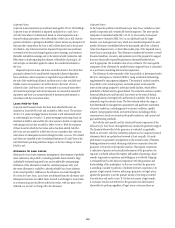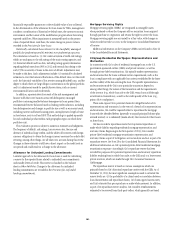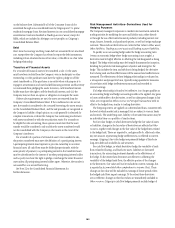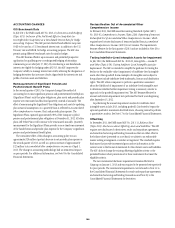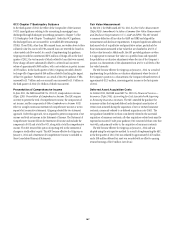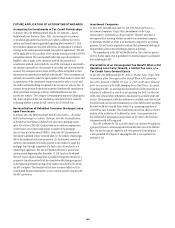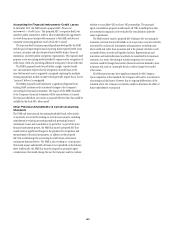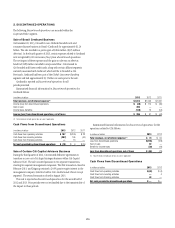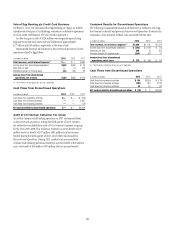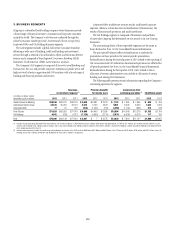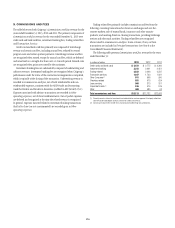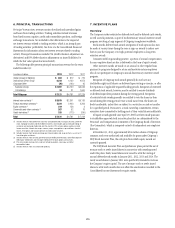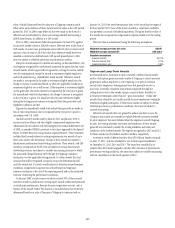Citibank 2013 Annual Report Download - page 186
Download and view the complete annual report
Please find page 186 of the 2013 Citibank annual report below. You can navigate through the pages in the report by either clicking on the pages listed below, or by using the keyword search tool below to find specific information within the annual report.168
FUTURE APPLICATION OF ACCOUNTING STANDARDS
Accounting for Investments in Tax Credit Partnerships
In January 2014, the FASB issued ASU 2014-01, Investments—Equity
Method and Joint Ventures (Topic 323): Accounting for Investments
in Qualified Affordable Housing Projects, which is effective for Citi for
interim and annual reporting periods beginning after December 15, 2014.
Any transition adjustment would be reflected as an adjustment to retained
earnings in the earliest period presented (retrospective application). The ASU
will be applicable to Citi’s portfolio of low income housing tax credit (LIHTC)
partnership interests. The new standard widens the scope of investments
eligible to elect to apply a new alternative method, the proportional
amortization method, under which the cost of the investment is amortized to
tax expense in proportion to the amount of tax credits and other tax benefits
received. Citi anticipates that its entire LIHTC portfolio will qualify to elect
the proportional amortization method under the ASU. These investments are
currently accounted for under the equity method, which results in losses (due
to amortization of the investment) being recognized in Other revenue and
tax credits and benefits being recognized in the Income tax expense line. In
contrast, the proportional amortization method combines the amortization
of the investment and receipt of the tax credits/benefits into one line,
Income tax expense. The Company is evaluating the impact of adopting this
ASU. Early adoption of this new standard is permitted and Citi is currently
evaluating whether to adopt the ASU early for the 2014 fiscal year.
Reclassification of Defaulted Consumer Mortgage Loans
upon Foreclosure
In January 2014, the FASB issued ASU 2014-04, Receivables—Troubled
Debt Restructurings by Creditors (Subtopic 310-40): Reclassification
of Residential Real Estate Collateralized Consumer Mortgage Loans
upon Foreclosure. This ASU clarifies when an in-substance repossession
or foreclosure occurs that would require a transfer of the mortgage
loan to other real estate owned (OREO). Under the ASU, repossession or
foreclosure is deemed to have occurred when (1) the creditor obtains legal
title to the residential real estate property or (2) the borrower conveys all
interest in the residential real estate property to the creditor to satisfy the
mortgage loan through completion of a deed in lieu of foreclosure or a
similar legal agreement. The ASU will become effective for annual and
interim periods beginning after December 15, 2014 and can be adopted.
The ASU can be adopted using either a modified retrospective method or a
prospective transition method with the cumulative effect being recognized
in the beginning retained earnings of the earliest annual period for which
the ASU is adopted. The standard will not have a material effect on Citi’s
Consolidated Financial Statements, as Citi’s current practice complies with
the ASU’s provisions.
Investment Companies
In June 2013, the FASB issued ASU No. 2013-08, Financial Services—
Investment Companies (Topic 946): Amendments to the Scope,
Measurement, and Disclosure Requirements. This ASU introduces a
new approach for assessing whether an entity is an investment company.
To determine whether an entity is an investment company for accounting
purposes, Citi will now be required to evaluate the fundamental and typical
characteristics of the entity including its purpose and design.
The amendments in the ASU will be effective for Citi in the first quarter
of 2014. Earlier application is prohibited. No material impact is anticipated
from adopting this ASU.
Presentation of an Unrecognized Tax Benefit When a Net
Operating Loss Carry-forward, a Similar Tax Loss, or a
Tax Credit Carry-forward Exists
In July 2013, the FASB issued ASU No. 2013-11, Income Taxes (Topic 740):
Presentation of an Unrecognized Tax Benefit When a Net Operating
Loss Carry-forward, a Similar Tax Loss, or a Tax Credit Carry-forward
Exists (a consensus of the FASB Emerging Issues Task Force). As a result
of applying this ASU, an unrecognized tax benefit should be presented as a
reduction of a deferred tax asset for a net operating loss (NOL) or other tax
credit carry-forward when settlement in this manner is available under the
tax law. The assessment of whether settlement is available under the tax law
would be based on facts and circumstances as of the balance sheet reporting
date and would not consider future events (e.g., upcoming expiration of
related NOL carry-forwards). This classification should not affect an entity’s
analysis of the realization of its deferred tax assets. Gross presentation in
the rollforward of unrecognized tax positions in the notes to the financial
statements would still be required.
This ASU is effective for Citi in its 2014 fiscal year, and may be applied on
a prospective basis to all unrecognized tax benefits that exist at the effective
date. Citi has the option to apply the ASU retrospectively. Early adoption
is also permitted. The impact of adopting this ASU is not expected to be
material to Citi.



